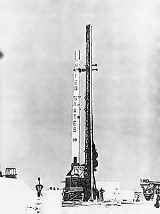
RM-90 Blue Scout II
Encyclopedia
The RM-90 Blue Scout II was an American
sounding rocket
and expendable launch system
which was flown three times during 1961. It was used for two HETS
test flights, and the launch of the Mercury-Scout 1
satellite for NASA
. It was a member of the Scout family of rockets.
The Blue Scout II was a military version of the NASA
-operated Scout X-1
. All three launches occurred from Launch Complex 18B
at the Cape Canaveral Air Force Station
, the same launch pad used for the Blue Scout I
. The first two launches were successfully conducted on 3 March and 12 April 1961 respectively. They both carried HETS A2 plasma
research experiments on suborbital trajectories. The third launch was conducted on 1 November, with the Mercury-Scout 1
satellite for NASA
, which was intended to reach low Earth orbit
. The launch failed after the rocket went out of control, and was destroyed by the range safety officer
43 seconds after liftoff.
United States
The United States of America is a federal constitutional republic comprising fifty states and a federal district...
sounding rocket
Sounding rocket
A sounding rocket, sometimes called a research rocket, is an instrument-carrying rocket designed to take measurements and perform scientific experiments during its sub-orbital flight. The origin of the term comes from nautical vocabulary, where to sound is to throw a weighted line from a ship into...
and expendable launch system
Expendable launch system
An expendable launch system is a launch system that uses an expendable launch vehicle to carry a payload into space. The vehicles used in expendable launch systems are designed to be used only once , and their components are not recovered for re-use after launch...
which was flown three times during 1961. It was used for two HETS
Hets
Hets may refer to:* A tribe in Argentina also known as the Querandíes or Pampas*Torment , a 1944 film by Alf Sjöberg and Ingmar BergmanHETS may refer to:*Heavy Equipment Transport System, a military logistics vehicle...
test flights, and the launch of the Mercury-Scout 1
Mercury-Scout 1
Mercury-Scout 1, or MS-1, was a United States spacecraft intended to test tracking stations for Project Mercury flights. It grew out of a May 5, 1961 NASA proposal to use Scout rockets to launch small satellites to evaluate the worldwide Mercury Tracking Network in preparation for manned orbital...
satellite for NASA
NASA
The National Aeronautics and Space Administration is the agency of the United States government that is responsible for the nation's civilian space program and for aeronautics and aerospace research...
. It was a member of the Scout family of rockets.
The Blue Scout II was a military version of the NASA
NASA
The National Aeronautics and Space Administration is the agency of the United States government that is responsible for the nation's civilian space program and for aeronautics and aerospace research...
-operated Scout X-1
Scout X-1
Scout X-1 was an American expendable launch system and sounding rocket which was flown seven times between August 1960 and October 1961. Four orbital and three suborbital launches were made, with four of the launches resulting in failures....
. All three launches occurred from Launch Complex 18B
Cape Canaveral Air Force Station Launch Complex 18
Launch Complex 18 is a launch complex at the Cape Canaveral Air Force Station, Florida that was active during the late 1950s and early 1960s. It was used by Viking, Vanguard, Thor and Scout rockets...
at the Cape Canaveral Air Force Station
Cape Canaveral Air Force Station
Cape Canaveral Air Force Station is an installation of the United States Air Force Space Command's 45th Space Wing, headquartered at nearby Patrick Air Force Base. Located on Cape Canaveral in the state of Florida, CCAFS is the primary launch head of America's Eastern Range with four launch pads...
, the same launch pad used for the Blue Scout I
RM-89 Blue Scout I
The RM-89 Blue Scout I was an American sounding rocket which was flown three times between January 1961 and April 1962. It was used for two HETS test flights, and a flight to investigate atmospheric re-entry. It was a member of the Scout family of rockets....
. The first two launches were successfully conducted on 3 March and 12 April 1961 respectively. They both carried HETS A2 plasma
Plasma (physics)
In physics and chemistry, plasma is a state of matter similar to gas in which a certain portion of the particles are ionized. Heating a gas may ionize its molecules or atoms , thus turning it into a plasma, which contains charged particles: positive ions and negative electrons or ions...
research experiments on suborbital trajectories. The third launch was conducted on 1 November, with the Mercury-Scout 1
Mercury-Scout 1
Mercury-Scout 1, or MS-1, was a United States spacecraft intended to test tracking stations for Project Mercury flights. It grew out of a May 5, 1961 NASA proposal to use Scout rockets to launch small satellites to evaluate the worldwide Mercury Tracking Network in preparation for manned orbital...
satellite for NASA
NASA
The National Aeronautics and Space Administration is the agency of the United States government that is responsible for the nation's civilian space program and for aeronautics and aerospace research...
, which was intended to reach low Earth orbit
Low Earth orbit
A low Earth orbit is generally defined as an orbit within the locus extending from the Earth’s surface up to an altitude of 2,000 km...
. The launch failed after the rocket went out of control, and was destroyed by the range safety officer
Range Safety Officer
In the field of rocketry, Range Safety Officer is a generic term referring to an individual who monitors the performance of rockets in flight, and who is responsible for their remote destruction if it should be judged that they pose a hazard...
43 seconds after liftoff.

